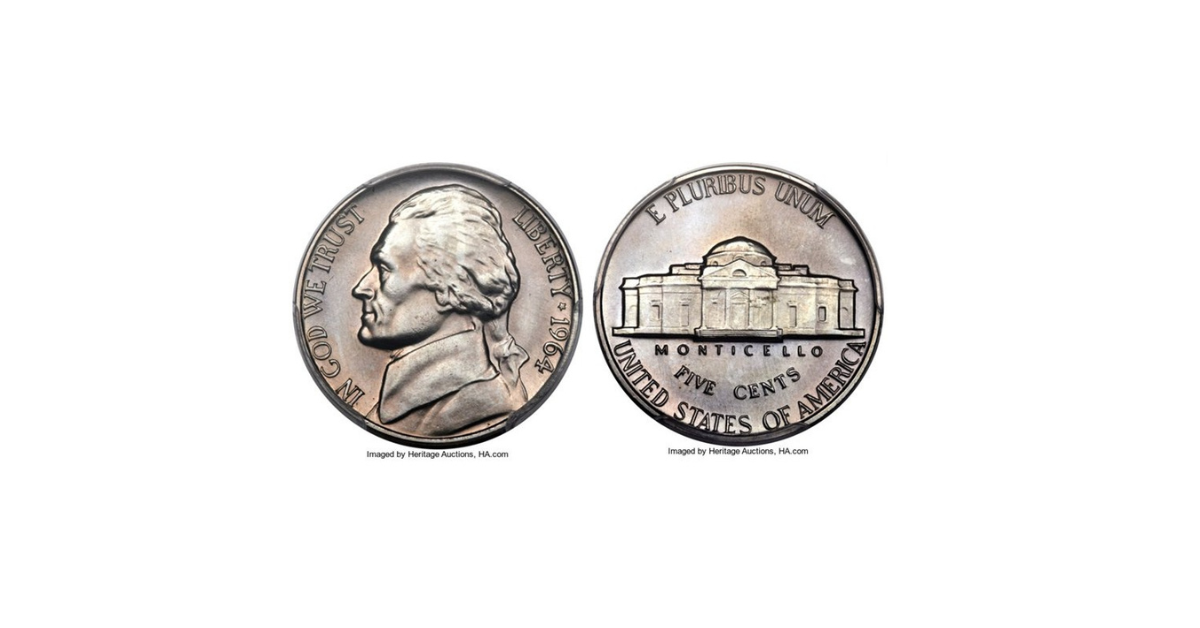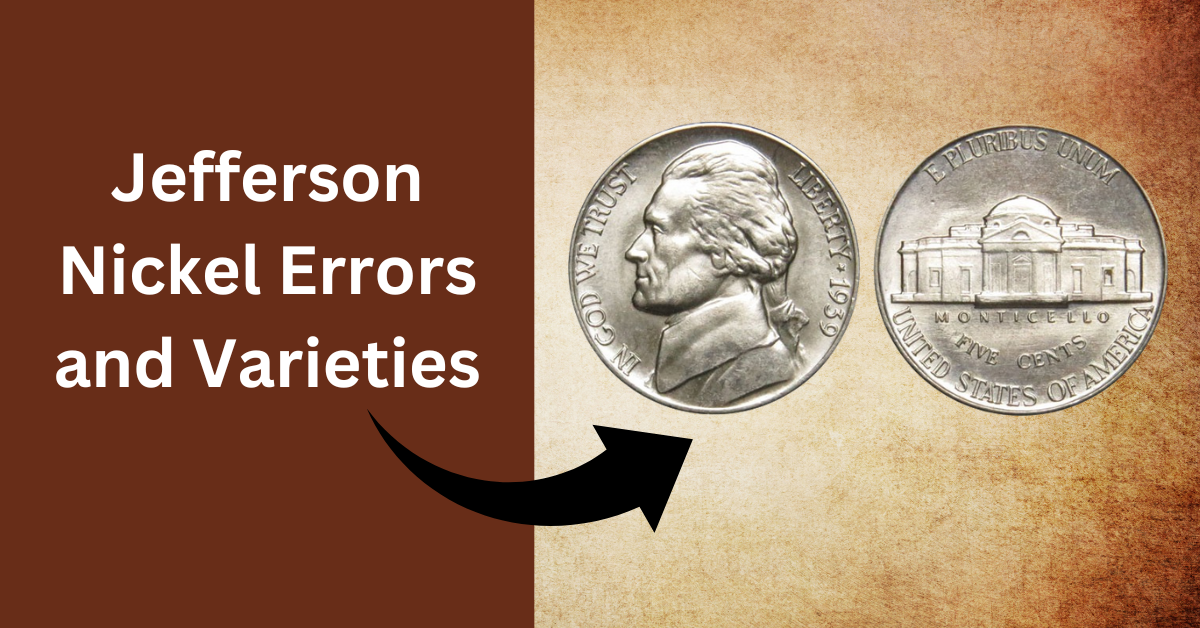Have you ever found an old or unusual nickel in your pocket and wondered if it might be worth something? While most people simply see nickels as just five-cent coins, there’s a surprising amount of value hidden in them—especially when it comes to rare errors. The U.S. Mint has been producing 5-cent nickels since 1866, and the Jefferson Nickel, minted from 1938 onward, is one of the most popular and commonly collected.
Most people don’t think much of nickels—they’re worth only a few cents after all. But here’s the secret: certain nickels with errors can be worth a lot more than their face value. These error coins are often more valuable than you’d imagine, with some selling for hundreds or even thousands of dollars.
As older nickels become increasingly scarce because they’re no longer in circulation, those with unique mistakes become even rarer—and more desirable. In this article, we’ll take you through some of the most valuable and interesting nickel errors. That way, you’ll know exactly what to look for when checking your spare change.
Most Valuable Nickel Errors Worth Money
1. 1937-D Three Legs Buffalo Nickel
The 1937-D Three Legs Buffalo Nickel is among the most well-known error coins in modern American currency. This nickel got its name because the buffalo on the reverse side is missing one of its legs. The missing leg is the result of over-polishing the die used to strike the coin, which created the error.
When the coin was first released, collectors quickly started searching for the three-legged buffalo, pulling many of these coins from circulation. Even though the Buffalo Nickel is no longer made today, examples in good condition are hard to come by, and those with this particular error are particularly rare. A coin graded MS66 was sold for an astounding $99,875 in 2021 at a Legend Rare Coins auction.
2. 1935 Doubled Die Reverse Buffalo Nickel
The 1935 Doubled Die Reverse Buffalo Nickel stands out as the only year in the Buffalo Nickel series to feature a significant doubled die reverse error. This error is most noticeable in the doubling of the inscriptions “E PLURIBUS UNUM” and “FIVE CENTS” on the reverse side.
The rarity of this error makes it highly collectible, and it exists in two varieties: Type 1 and Type 2. Type 1 shows a more noticeable doubling, which makes it more valuable. In 2007, a Type 1 coin in MS64 grade sold for $104,650 at auction.
3. 1964 SMS Jefferson Nickel
In 1964, the U.S. Mint issued a special set of coins, known as the Special Mint Set (SMS), that included the Jefferson Nickel. These coins were never released into circulation, making them incredibly rare. Only a few of these special-strike nickels are known to exist, and they weren’t discovered until nearly 30 years later, in 1993.

Unlike business strikes or proof coins, these 1964 SMS Jefferson Nickels were struck with a satin finish and a frosty detail, giving them a distinct appearance. In particular, nickels with full bands on the reverse are highly prized. A coin in this condition sold for $32,900 at auction.
4. 1918-S Buffalo Nickel
The 1918-S Buffalo Nickel is another rare find. The San Francisco Mint struck only about 4.88 million of these nickels, many of which had poor strikes. As a result, finding one in good condition, especially with sharp details, is incredibly rare.
These nickels are especially sought after by collectors who appreciate their historical value. A top-grade 1918-S Buffalo Nickel in MS66 condition sold for $125,350 at an auction in 2008, highlighting just how valuable a well-preserved example can be.
5. 1913 Liberty Head Nickel
The 1913 Liberty Head Nickel is one of the most famous and rarest coins in American numismatics. Only five examples of this coin are known to exist, making it a true treasure for collectors.
Despite the fact that the Buffalo Nickel was supposed to replace the Liberty Head Nickel in 1913, these coins were struck that year—why exactly remains a mystery. The existence of these coins was shrouded in secrecy until 2013, when the last remaining example, known as the Walton Nickel, was discovered. This coin was later sold for $4,560,000 in 2022 at auction, solidifying its place as one of the most valuable coins in the world.
6. 1918/7-D Buffalo Nickel Doubled Die Obverse
The 1918/7-D Buffalo Nickel is an extremely rare coin, and one of the most famous in the Buffalo Nickel series. It features a date that overlaps two years—1917 and 1918—because two different hubs were used to strike the obverse die.
Collectors didn’t even realize this error until about 13 years after the coin’s release, but once they did, it quickly became a prized item. In 2006, an MS65 example of the 1918/7-D Buffalo Nickel sold for a staggering $350,750.
7. 1939-P Doubled Die Reverse (Full Step)
The 1939-P Doubled Die Reverse is another key error in the Jefferson Nickel series. The doubling on the reverse is most noticeable around the words “MONTICELLO” and “FIVE CENTS.”

This coin is relatively rare, with only about 1,000 examples in circulation. The most valuable are those in mint state with full steps, which means the steps on the reverse of Thomas Jefferson’s home are fully visible. One of these examples sold for $23,500, highlighting how important condition is when determining a coin’s value.
8. 1950-D Jefferson Nickel
The 1950-D Jefferson Nickel is noteworthy not for an error, but for its low mintage. In 1950, the Denver Mint struck fewer of these coins than usual, making them harder to find today.
While circulated examples are still relatively common, coins in mint state are much harder to come by. A 1950-D Jefferson Nickel in MS66 condition sold for over $50,000 in 2019, proving how a low mintage can turn a coin into a valuable collector’s item.
9. 1949-S Jefferson Nickel with Reverse Die Chip
The 1949-S Jefferson Nickel has a small but noticeable reverse die chip, making it a unique variety of the regular 1949-S. While this chip is subtle, it makes the coin more desirable among collectors, as it adds to its rarity.
One example of this variety was sold for over $2,500 at auction, showcasing how even small, often overlooked errors can increase the value of a coin.
10. 1971-S Jefferson Nickel with Doubled Die Obverse
The 1971-S Jefferson Nickel features a doubled die error on the obverse. The doubling is most noticeable in the word “LIBERTY” and the date.
Though this error is relatively rare, a few examples have been discovered. One such example sold for over $1,000 at auction, proving that even a minor doubling error can add significant value to a coin.
How to Spot Rare Nickel Errors
Spotting a rare nickel error can be challenging, but with a trained eye, it’s possible to find something valuable in your change. Look for doubling, missing elements in the design, or unusual marks on the coin’s surface. The condition of the coin also plays a huge role in its value, so always check for signs of wear and tear that may affect its worth.
If you come across a nickel that seems to have an error, do some research to determine if it’s one of the rarities listed above. The right find could make you a small fortune—so keep an eye out!
Conclusion: The Thrill of Coin Collecting
Collecting nickels is more than just a hobby—it’s a fascinating way to uncover hidden treasures that have significant historical value. While most nickels are worth just a few cents, the error varieties we’ve covered here can fetch hundreds or even thousands of dollars.
Whether you’re a seasoned collector or a beginner, it’s always worth taking a second look at the nickels in your pocket change. Some of the rarest and most valuable coins are sitting right under our noses, just waiting to be discovered. And remember, the fun of collecting isn’t just about finding valuable coins—it’s about the thrill of learning more about history and the fascinating world of numismatics.
Happy hunting, and who knows? Your next nickel might just be worth a lot more than you think!
